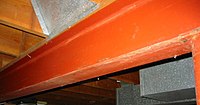
Photo from wikipedia
Multi‐axial forging (MAF) at room temperature is employed to investigate the effects of deformation processing path and the amount of imposed strain on the deformation mechanisms of a twinning‐induced plasticity… Click to show full abstract
Multi‐axial forging (MAF) at room temperature is employed to investigate the effects of deformation processing path and the amount of imposed strain on the deformation mechanisms of a twinning‐induced plasticity (TWIP) steel. The results indicate that the twin frequency is decreased by applying the 2nd compression (∑ɛ = 0.8), however, an unexpected increase is realized at the end of first MAF pass (∑ɛ = 1.2). This is attributed to the change in strain path and orientation dependence of deformation twinning. The latter is phenomenal considering the previous researches reporting the suppression of twinning at the early stage of deformation (ɛ < 0.4). The same sequence is followed during the second pass of MAF process. Interestingly, the progressive and continues substructure development along with dynamic Hall–Petch effect results from deformation twinning leads to an appreciable grain refinement. The latter is accompanied by the sharp drop of hardening rate in corresponding flow curves. The microtexture analysis indicates the strengthened texture of the 1 pass‐processed specimens which is weaken at the end of 2 pass due to the recrystallization and increasing the number of texture component. The current work also explores the room temperature mechanical properties of the multi axial forged workpiece through elaborating the miniaturized tensile testing method.
Journal Title: Advanced Engineering Materials
Year Published: 2018
Link to full text (if available)
Share on Social Media: Sign Up to like & get
recommendations!